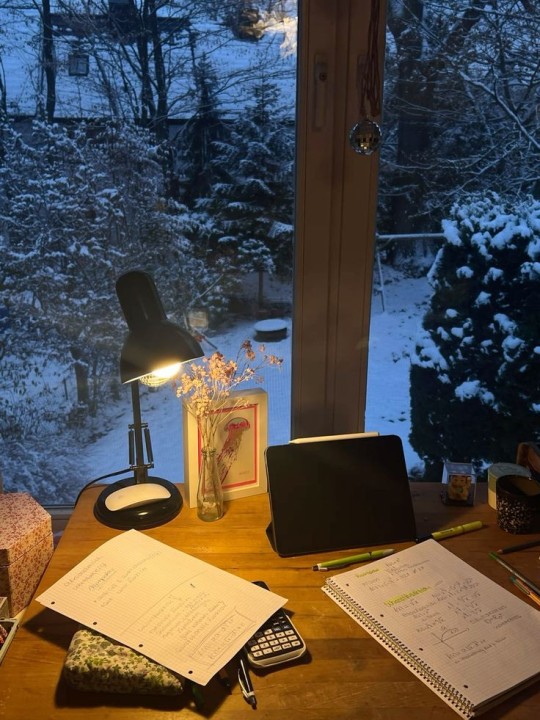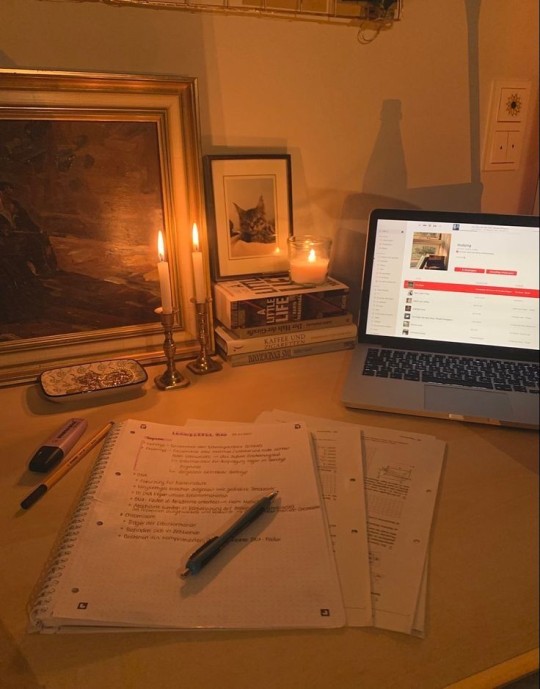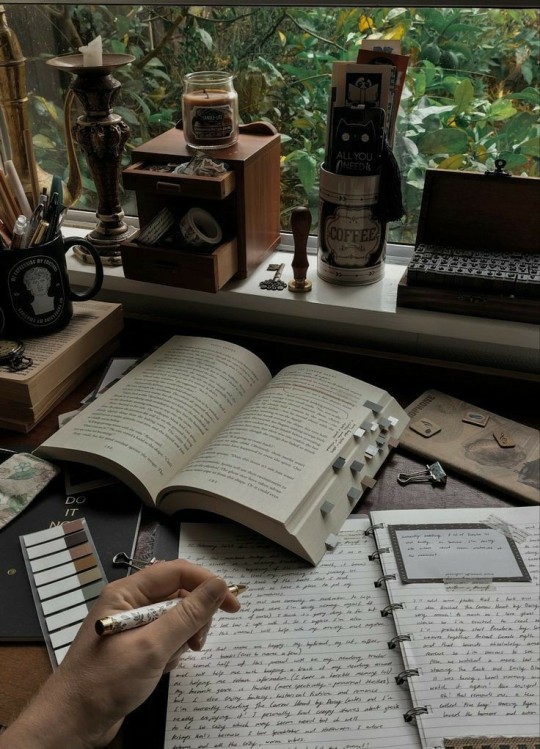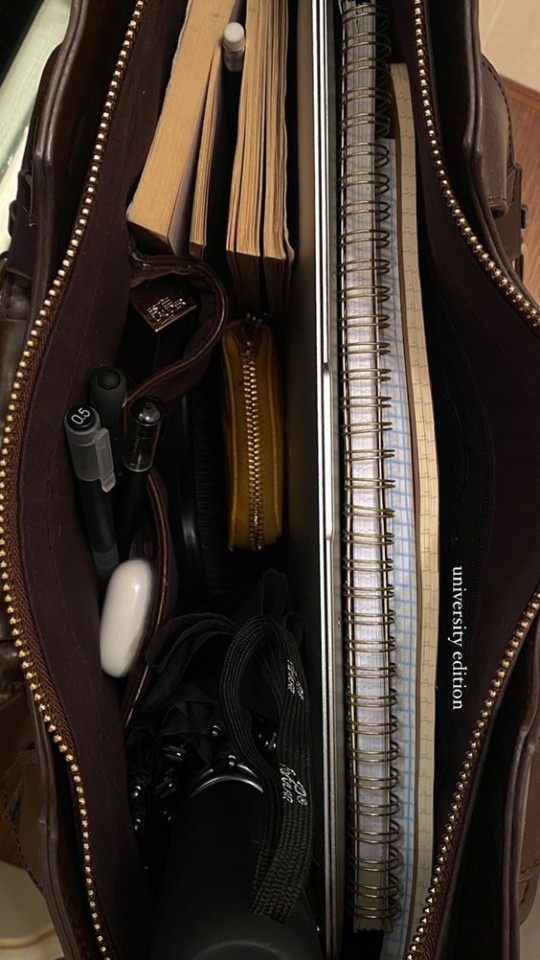#Notes tips
Explore tagged Tumblr posts
Text
Refilled my compact tool for note taking
2 notes
·
View notes
Text
gentle reminder you can rise up from everything. you can recreate yourself. nothing is permanent. you are not stuck. you have choices. you can think new thoughts. you can learn something new. you can create new habits. all that matters is that you decide today and never look back.
#college#education#school#academia#note taking#student#study aesthetic#study blog#study inspiration#study motivation#study notes#study tips#studyblr#studyinspo#studyspo#uni life#university life#university#academic validation#chaotic academia#light academia#dark academia#motivation#motivating quotes#motivational quotes
27K notes
·
View notes
Text




Studying with a tired heart and a hopeful mind
#aesthetic#books & libraries#studyspo#studyblr#study aesthetic#study space#light academia#studying#study#student#student life#mine#study hard#study desk#study blog#study motivation#study inspiration#study inspo#university#100 days of productivity#study tips#study notes#bookworm#book quotes#bookblr#books#book aesthetic#college#studygram#studyblr community
4K notes
·
View notes
Text
We already have a Minecraft movie. It’s called The Great Potato War and it’s available in three parts on YouTube.com/technoblade
#hat tip to the person in my notes who referenced this and I went YO#technoblade#bladeblr#medusas banger posts
10K notes
·
View notes
Text
Writing Notes: Stages of Decomposition

The decomposition process occurs in several stages following death:
Pallor mortis
Algor mortis
Rigor mortis
Cadaveric spasm
Lividity
Putrefaction
Decomposition
Skeletonization
PALLOR MORTIS
The first stage of death.
Occurs once blood stops circulating in the body.
The cessation of an oxygenated blood flow to the capillaries beneath the skin causes the deceased to pale in appearance.
In non-Caucasians, the pallor may appear to develop an unusual hue; the skin will lose any natural lustre and appears more waxen.
Occurs quite quickly, within about 10 minutes after death.
ALGOR MORTIS
The cooling of the body after death.
The cooling process will be influenced by many factors, including the deceased’s clothing, or whether they are covered with bed linen such as blankets or duvets.
The body will typically cool to the ambient room temperature, but this alters if there is heating in the room or if there is a constant draught cooling the body.
RIGOR MORTIS
Can occur between 2 and 6 hours after death.
Factors including temperature can greatly affect this.
Caused by the muscles partially contracting, and the lack of aerobic respiration means that the muscles cannot relax from the contraction, leaving them tense, subsequently resulting in the stiffening we associate with rigor mortis.
This stage typically begins in the head, starting with the eyes, mouth, jaw and neck, and progresses right through the body.
The process is concluded approximately 12 hours after death (although, again, certain variables may occur) and lasts between 24 and 72 hours depending on circumstances.
Contrary to popular belief, rigor mortis is not a permanent state and is in fact reversed, with the muscles relaxing in the same order in which they initially stiffened.
The reversing process also takes approximately 12 hours, when the body returns to its un-contracted state.
It is possible to ‘break’ rigor mortis by manipulating and flexing the limbs. This is usually done by undertakers, pathologists or crime scene investigators who are attempting to examine or move a body – or by a murderer trying to hide their victim in the closet or the boot of a car.
CADAVERIC SPASM
A phenomenon that can be misinterpreted as rigor mortis.
The instantaneous stiffening of the body (most commonly the hands) following a traumatic death.
Unlike rigor mortis, the stiffening of the affected limb is permanent and is not reversed, causing the deceased to maintain the rigidity until such time as putrefaction causes breakdown of the particular muscle group.
Examples:
The deceased following an air crash were later discovered still clutching their seatbelts or arm rests in a final, desperate act of survival.
In a drowning case, the victim was discovered with grass from the riverbank still grasped in their hand.
Perhaps the most famous case of cadaveric spasm involves the rock band Nirvana’s lead singer, Kurt Cobain. Cobain reportedly committed suicide in April 1994. His body was discovered a few days after his death with a shotgun wound to the head, and tests revealed he had large traces of heroin in his system. He was reportedly discovered still clutching the gun in his left hand, due to cadaveric spasm. However, a great deal of controversy surrounds the veracity of this latter assumption, and indeed the cause of his death, with many people insisting and attempting to prove that he died as the result of foul play rather than suicide.
LIVIDITY
Also known as livor mortis, hypostasis, or suggillation.
Once blood can no longer circulate, it will gravitate towards the lowest point of the body.
Example: A supine body will display pinkish/purple patches of discoloration where the blood has settled in the back and along the thighs.
Occurs about 30 minutes after death, but will not necessarily be noticeable until at least 2 hours afterwards as the pooling process intensifies and becomes visible, finally peaking up to between 8 and 12 hours later.
Once it is complete, the lividity process cannot be reversed.
Therefore a body discovered lying on its side, but with staining evident in the back and shoulders, must have been moved at some point from what would have been a supine position at the time of death.
It is worth noting that if the body has had contact with the floor, a wall or other solid surface, lividity would not occur at the points of contact as the pressure would not allow the blood to seep through the capillaries and pool. The specific area of pressure will be the same colour as the rest of the body and a pattern of contact may well be evident.
PUTREFACTION
Derives from the Latin putrefacere, meaning ‘to make rotten’.
The body becomes rotten through the process known as autolysis, which is the liquefaction of bodily tissue and organs and the breakdown of proteins within the body due to the increased presence of bacteria.
The first visible sign is the discoloration of the skin in the area of the abdomen.
Bacteria released from the intestine cause the body to become bloated with a mixture of gases; over time these will leak out, and the smell will intensify to unbearable proportions.
Typically, this will attract flies that will lay eggs, which develop into maggots.
Bloating is most evident in the stomach area, genitals and face, which can become unrecognizable as the tongue and eyes are forced to protrude due to the pressure of the build-up of gases in the body.
At this stage, the body will also begin to lose hair.
The organs typically decompose in a particular order: starting with the stomach, followed by the intestines, heart, liver, brain, lungs, kidney, bladder and uterus/prostate.
Once all the gases have escaped the skin begins to turn black: this stage is called ‘black putrefaction’.
As with all the other stages of death so far, the rate of putrefaction depends on temperature and location. A body exposed to the air above ground will decompose more quickly than a body left in water or buried below ground.
During putrefaction, blistering of the skin and fermentation can also occur:
Fermentation - a type of mould that will grow on the surface of the body. This mould appears white, and is slimy or furry in texture. It also releases a very strong, unpleasant, cheesy smell.
As the putrefaction process comes to an end, fly and maggot activity will become less, which leads to the next stage.
DECOMPOSITION
The body is an organic substance comprising organisms that can be broken down by chemical decomposition.
If the body is outside, any remains that have not been scavenged or consumed by maggots will liquefy and seep into the surrounding soil.
Thus when the body decomposes it is effectively recycled and returned to nature.
SKELETONIZATION
The final stage of death is known as ‘dry decay’, when the cadaver has all but dried out: the soft tissue has all gone and only the skeleton remains.
If the cadaver is outside, not only is it exposed to the elements but it also becomes food for scavengers such as rats, crows or foxes.
As the remains are scavenged, the body parts become dispersed so it is not unusual to find skeletal remains some distance from where the body lay at the point of death.
The way in which skeletal remains are scattered in such cases is of interest to archaeologists, and is referred to as taphonomy.
Where a body has lain undiscovered at home for a period of time it has also been known for family pets, typically dogs, to feed on the body. The natural instinct of a pet is to attempt to arouse the deceased by licking them, but once it gets hungry, its survival instinct will take over and it will consider the body as little more than carrion: it will act with the same natural instinct as a scavenger in the wild, which will feed on any corpse, be it animal or human, if it is starving.
Obviously the number of pets, the body mass of the deceased and the time lapse before the body is discovered will influence to what extent it has been devoured.
For further research on the stages of decomposition and the factors that affect it, look up body farms. These are medical facilities where bodies are donated for research purposes so scientists can specifically observe the decomposition process. However, be aware that some of the images are quite graphic.
Source ⚜ More: References ⚜ Autopsy ⚜ Pain & Violence ⚜ Injuries Bereavement ⚜ Death & Sacrifice ⚜ Cheating Death ⚜ Death Conceptions
Writing Resources PDFs
#writing reference#decomposition#writeblr#spilled ink#dark academia#writing notes#fiction#creative writing#novel#light academia#literature#writers on tumblr#léon cogniet#poets on tumblr#writing prompt#poetry#writing prompts#writing tips#crime fiction#writing resources
4K notes
·
View notes
Text


I will succeed. Not instantly. But definitely.
#study motivation#studyblr#girl blogger#quotes#study inspiration#studyspo#studying#study inspo#study blog#study goals#study motivator#student#study movitation#harsh studyspo#study aesthetic#studyblr community#college#education#school#note taking#study notes#study tips#studyinspo#study life#university life#university#chaotic academia#dark academia#light academia#motivation
3K notes
·
View notes
Text
shout out to when i told my dad about goncharov and he figured out it was fake because i told him "1973 martin scorsese film with robert de niro" and he said that wasn't possible because the godfather came out in 1972 and the godfather part II came out in 1974 and they wouldn't have had time to make a movie in between. a perfectly good jest, foiled by this man's weird and vast knowledge set
#edit i remembered this incorrectly#i confused robert de niro with al pacino he was actually what tipped my dad off#i'll be honest i've never seen the godfather? the only mafia movies i've watched are goodfellas and 1996 lesbian masterpiece bound#so i'm not really familiar with the genre lol#EDIT AGAIN IF ANYONE CARES: I HAVE SEEN GODFATHER PART I AND II NOW. I KNOW HOW WRONG I WAS. WHY DID THIS GO UP 500 NOTES IT'S BEEN MONTHS#goncharov#goncharov 1973#eddie genius posting
26K notes
·
View notes
Text


Got finally accepted into my chosen Grad School and I'm so excited to start! 🥳
What are your tips or things you wish you knew before starting grad school? 📖
#italian studyblr#studyblr#notes#study#studying#notebook#books#student#students#grad school#grad student#grad studies#grad studyblr#studio#study blog#study motivation#study hard#study abroad#study aesthetic#study academia#light academia#chaotic academia#chaotic academic aesthetic#art books#student life#college student#student's life#art history#study tips#room aesthetic
2K notes
·
View notes
Text


I will succeed. Not immediately. But definitely.
#study motivation#studyblr#quotes#study inspiration#studyspo#studying#study blog#study goals#study motivator#student#harsh studyspo#study aesthetic#studyblr community#bella_studies#college#education#school#academia#note taking#study notes#study tips#studyinspo#uni life#university life#university#academic validation#chaotic academia#light academia#dark academia#motivation
6K notes
·
View notes
Text
I love haiku bot. This is a haiku I think please recognise it.
#this probably wont work but a girl can dream#i even broke out the capitol letters for this#haiku bot#the only bot i like#haiku#poetry#any tips to get recognised by the haiku bot are appreciated#please share so the haiku bot may see me#does it even care about notes or is that irrelevant#idk#its my dream to be noticed by the haiku bot#not gonna lie im not 100% sure this is a haiku but i think it is#i tried and will try again if this doesnt work#one day i will be seen
2K notes
·
View notes
Text






77/100 days of productivity!
Saturday reset mode: activated. You’re building something bigger than just a productive day—you’re building resilience, discipline, and balance. Keep going!
Log: 23 Feb
☀ Morning ▸ Breakfast + journal ▸ Research Work (RO) ▸ Light stretching
🌿 Afternoon ▸ Deep-clean workspace + tidy up ▸ Lunch+ write up ▸ Catch up on research (editing)
���� Evening ▸ Call home ▸ Yoga ▸ Go shopping ▸ Wind down with a movie or podcast
#studyblr#stem academia#100 days of productivity#women in stem#study space#study motivation#study blog#studyspo#realistic studyblr#stem student#stemblr#student#student life#study aesthetic#study desk#study hard#study inspiration#study notes#study with me#study tips#studyblr community#studygram#studying#studyinspo#university student#academia#academic validation#academics#classic academia#dark acadamia aesthetic
2K notes
·
View notes
Text
Main character energy :
Astrology Observations Part - 6 :

Sun - Ascendant / Leo rising : these natals have a very friendly presence.. they r well-liked, confident and charismatic. They grab everyone's attention when they walk into a room.. all eyes r on them.. all the time. And these natals r comfortable with everyone's attention.
Sun - Mars(positive aspects) : these natals have a double dose of healthy masculinity..they r a powerhouse of unlimited energy. although they r naturally competitive.. people find them really admirable because they r not forceful with their competitiveness.. these natals r zealous about problem solving.
Sun - Jupiter(positive aspects) : these natals r good hearted.. they believe in fair play. They r blessed with radiant positivity, good luck, happiness, enthusiasm and self-confidence. Truly blessed bunch. They seem like god's favorite children.. that's their vibe.
Jupiter - Ascendant / Sagittarius ascendant : these natals have a larger than life.. personality. They r optimistic and they have an uplifting spirit. This individual is the type of friend who invites people to go on adventures.
Venus - Mars (positive aspects) : not only do these natals ooze sex appeal... They also have a very healthy emotional health .. people feel very comfortable around these natals because of how comfortable they r with their masculinity and femininity.
Mars - Jupiter(positive aspects) : these natals are blessed with energy, sincerity, frankness, a sense of adventure and a love for life / living. They r extremely ambitious in their endeavours and they r blessed with luck as well.
Leo in the 10th house : these natal's work revolves around uplifting / helping others for a living... These natals take pride in their job. They r driven and ambitious about making an impact.
#main character#main character energy#astrology on tumblr#astrology observation#astrology observations#natal astrology#sun aspects#venus aspects#astrologer#astrology signs#astrology#astrology blog#astrology aspects#astrology community#astro chart#astrology help#astrology houses#astrology meme#astrology memes#astrology placements#astrology notes#astrology posts#astrology tumblr#astrology tips#zodiac#zodiac placements#house placements#sun astrology#ascendant#rising signs
2K notes
·
View notes
Text



it gets easier. everyday, it gets a little easier, but you gotta do it everyday. that's the hard part. but i promise it gets easier.
#college#education#school#academia#student#study aesthetic#study blog#study inspiration#study motivation#note taking#i should study#college student#student life#studying#study community#study notes#study space#study tips#studyblr#studyblr community#studyinspo#studyspo#uni student#university life#uni life#university#light academia#academic overachiever#dark academia#academic validation
4K notes
·
View notes
Text




Even when you're tired, remember why you started.
#books & libraries#studyblr#studyspo#study aesthetic#aesthetic#study space#study#student#studying#student life#study hard#study desk#study blog#study motivation#study inspiration#study tips#study notes#studyblr community#study with me#college#college life#homework#i hope you like them#studyspiration#studygram#bookish#book aesthetic#books#bookworm#university
8K notes
·
View notes
Text
Astro observations• Win over your crush (based on their Venus signs)



Fire Venus - Aries, Leo, Sagittarius
These passionate guys are into girls with a lively, bold attitude! They're attracted to someone who's a bit feisty and full of energy. If you're super spirited or the ultimate damsel in distress, you'll spark their desire to protect you. But, do not come on too strong, they lose interest if it's too easy. Sagittarius loves the thrill of the chase. If you seem a bit out of reach, you'll catch his interest. Stay calm and let him come to you first—he'll be hooked before you know it.
Water Venus - Pisces, Cancer, Scorpio
These water Venus adore the delicate, nurturing types or the big-sister / big-brother figure. They're all about either being the protector or finding someone who can keep them in check. Beware that their possessiveness and insecurity can be intense. Forget about money, status, or looks - they want someone imperfect but completely theirs.
Air Venus - Gemini, Libra, Aquarius
Air Venus are all smart, independent thinkers who can navigate social situations effortlessly. They value high emotional intelligence! And Libra? They're totally into good looks. You don't have to be a chef, but you should shine in social settings. Keep them curious and fascinated, and you're well on your way to capturing their hearts.
Earth Venus - Capricorn, Taurus, Virgo
These guys are secretly hopeless romantics! You need to take the initiative—they're easy to win if you're bold. But they're really particular about settling down. They're the dependable partner type—steady and reliable, but not overly romantic. They love having someone by their side and thrive on routine. Once they get used to you, you're golden. Surprise them, and they'll be totally smitten!
>> Back to Masterlist ✧ Explicit Content
Qualities HE needs for significant partner
Qualities SHE needs of Significant others
Moon signs show the quality of partner they desire
Exclusive access : Patreon
/ instagram : @le.sinex / @botanicalsword
#astro#astrology placement#overlays#synastry#astro observations#synastry observations#astro posts#astro community#astrology#loa#composite venus#astro placements#astrology notes#astrology placements#astrology observations#astro memes#mars synastry#asteroid astrology#house synastry#loa tips#venus synastry#venus aspects#venus signs#venus mars
1K notes
·
View notes
Text
Writing Notes: Children's Dialogue
Language is extremely complex, yet children already know most of the grammar of their native language(s) before they are 5 years old.
BABBLING
Babbling begins at about 6 months and is considered the earliest stage of language acquisition
By 1 year babbles are composed only of the phonemes used in the language(s) they hear
Deaf babies babble with their hands like hearing babies babble using sounds
FIRST WORDS
After the age of one, children figure out that sounds are related to meanings and start to produce their first words
Usually children go through a holophrastic stage, where their one-word utterances may convey more meaning
Example: "Up" is used to indicate something in the sky or to mean “pick me up”
Most common first words (among the first 10 words uttered in many languages): “mommy,” “daddy,” “woof woof,” “no,” “bye,” “hi,” “yes,” “vroom,” “ball�� and “banana”
WORD MEANINGS
When learning words, children often overextend a word’s meaning
Example: Using the word dog to refer to any furry, four-legged animal (overextensions tend to be based on shape, size, or texture, but never color)
They may also underextend a word’s meaning
Example: Using the word dog to refer only to the family pet, as if dog were a proper noun
The Whole Object Principle: When a child learns a new word, (s)he is likely to interpret the word to refer to a whole object rather than one of its parts
SYNTAX
At about two years of age, children start to put words together to form two-word utterances
The intonation contour extends over the two words as a unit, and the two-word utterances can convey a range of meanings:
Example: "mommy sock" = subject + object or possessive
NOTE: Chronological age is NOT a good measure of linguistic development due to individual differences, so instead linguists use the child’s mean length of utterance (MLU) to measure development
The telegraphic stage describes a phase when children tend to omit function morphemes such as articles, subject pronouns, auxiliaries, and verbal inflection
Examples: "He play little tune" or "Andrew want that"
Between 2;6 and 3;6 a language explosion occurs and children undergo rapid development
By the age of 3, most children consistently use function morphemes and can produce complex syntactic structures:
Examples: "He was stuck and I got him out" / "It’s too early for us to eat"
After 3;6 children can produce wh-questions, and relative pronouns
Sometime after 4;0 children have acquired most of the adult syntactic competence
PRAGMATICS
Deixis: Children often have problems with the shifting reference of pronouns
Children may refer to themselves as "you"
Problems with the context-dependent nature of deictic words: Children often assume the hearer knows who s/he is talking about
AUXILIARIES
In the telegraphic stage, children often omit auxiliaries from their speech but can form questions (with rising intonation) and negative sentences
Examples: "I ride train?" / "I not like this book"
As children acquire auxiliaries in questions and negative sentences, they generally use them correctly
SIGNED LANGUAGES
Deaf babies acquire sign language in the same way that hearing babies acquire spoken language: babbling, holophrastic stage, telegraphic stage
When deaf babies are not exposed to sign language, they will create their own signs, complete with systematic rules
IMITATION, REINFORCEMENT, ANALOGY
Children do imitate the speech heard around them to a certain extent, but language acquisition goes beyond imitation
Children produce utterances that they never hear from adults around them, such as "holded" or "tooths"
Children cannot imitate adults fully while acquiring grammar
Example:
Adult: "Where can I put them?" Child: "Where I can put them?"
Children who develop the ability to speak later in their childhood can understand the language spoken around them even if they cannot imitate it
NOTE: Children May Resist Correction
Example: Cazden (1972) (observation attributed to Jean Berko Gleason) – My teacher holded the baby rabbits and we patted them. – Did you say your teacher held the baby rabbits? – Yes. – What did you say she did? – She holded the baby rabbits and we patted them. – Did you say she held them tightly? – No, she holded them loosely.
Another theory asserts that children hear a sentence and then use it as a model to form other sentences by analogy
But while analogy may work in some situations, certainly not in all situations:
– I painted a red barn. – I painted a barn red. – I saw a red barn. – I saw a barn red.
Children never make mistakes of this kind based on analogy which shows that they understand structure dependency at a very young age
BIRTH ORDER
Children’s birth order may affect their speech.
Firstborns often speak earlier than later-born children, most likely because they get more one-on-one attention from parents.
They favor different words than their siblings.
Whereas firstborns gabble on about animals and favorite colors, the rest of the pack cut to the chase with “brother,” “sister,” “hate” and such treats as “candy,” “popsicles” and “donuts.”
The social dynamics of siblings, it would appear, prime their vocabularies for a reality different than the firstborns’ idyllic world of sheep, owls, the green of the earth and the blue of the sky.
MOTHER'S LEVEL OF EDUCATION
Children may adopt vocabulary quite differently depending on their mother’s level of education.
In American English, among the words disproportionately favored by the children of mothers who have not completed secondary education are: “so,” “walker,” “gum,” “candy,” “each,” “could,” “wish,” “but,” “penny” and “be” (ordered starting with the highest frequency).
The words favored by the children of mothers in the “college and above” category are: “sheep,” “giraffe,” “cockadoodledoo,” “quack quack,” the babysitter’s name, “gentle,” “owl,” “zebra,” “play dough” and “mittens.”
BOYS / GIRLS
One area of remarkable consistency across language groups is the degree to which the language of children is gendered.
The words more likely to be used by American girls than by boys are: “dress,” “vagina,” “tights,” “doll,” “necklace,” “pretty,” “underpants,” “purse,” “girl” and “sweater.”
Whereas those favored by boys are “penis,” “vroom,” “tractor,” “truck,” “hammer,” “bat,” “dump,” “firetruck,” “police” and “motorcycle.”
Tips for Writing Children's Dialogue (compiled from various sources cited below):
Milestones - The dialogue you write should be consistent with the child's developmental milestones for their age. Of course, other factors should be considered such as if the child has any speech or intellectual difficulties. Also note that developmental milestones are not set in stone and each child is unique in their own way.
Too "Cutesy" - If your child characters are going to be cute, they must be cute naturally through the force of their personality, not because the entire purpose of their existence is to be adorable.
Too Wise - It’s true kids have the benefit of seeing some situations a little more objectively than adults. But when they start calmly and unwittingly spouting all the answers, the results often seem more clichéd and convenient than impressive or ironic.
Unintelligent - Don’t confuse a child’s lack of experience with lack of intelligence.
Baby Talk - Don’t make a habit of letting them misuse words. Children are more intelligent than most people think.
Unique Individuals - Adults often tend to lump all children into a single category: cute, small, loud, and occasionally annoying. Look beyond the stereotype.
Personal Goals - The single ingredient that transforms someone from a static character to a dynamic character is a goal. It can be easy to forget kids also have goals. Kids are arguably even more defined by their goals than are adults. Kids want something every waking minute. Their entire existence is wrapped up in wanting something and figuring out how to get it.
Don't Forget your Character IS a Child - Most of the pitfalls in how to write child characters have to do with making them too simplistic and childish. But don’t fall into the opposite trap either: don’t create child characters who are essentially adults in little bodies.
Your Personal Observation - To write dialogue that truly sounds like it could come from a child, start by being an attentive listener. Spend time around children and observe how they interact with their peers and adults. You can also study other pieces of media that show/write about children's behaviour (e.g., documentaries, films, TV shows, even other written works like novels and scripts).
Context - The context in which children speak is crucial to creating realistic dialogue. Consider their environment, who they're speaking to, and what's happening around them. Dialogue can change drastically depending on whether a child is talking to a friend, a parent, or a teacher. Additionally, children's language can be influenced by their cultural background, family dynamics, and personal experiences. Make sure the context informs the dialogue, lending credibility to your characters' voices.
Sources and other related articles: 1 2 3 4 5 6 7 8 9 10
Writing Notes: On Children ⚜ Childhood Bilingualism More: Writing Notes & References ⚜ Writing Resources PDFs
#writing prompt#writeblr#writers on tumblr#spilled ink#poets on tumblr#writing notes#children#writing tips#literature#writing advice#writing reference#studyblr#langblr#linguistics#dark academia#dialogue#writing resources
4K notes
·
View notes